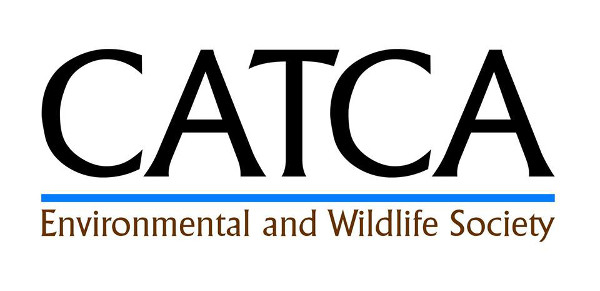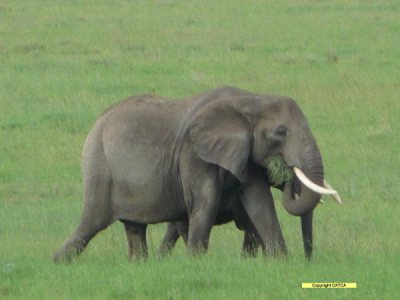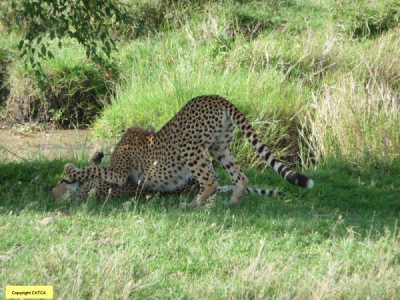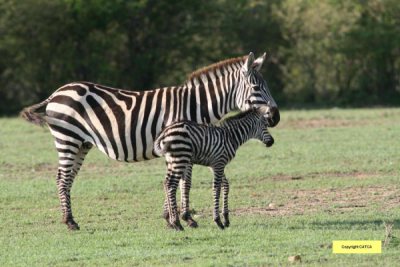

Kenya Wildlife Service Interview
Kenya Wildlife Service 2010 working with the communities to protect Kenyan wildlife.
The Kenya Wildlife Service (better known as KWS), was created in 1990 as a way to enforce and counter attack the elephant poachers in that country. In 1989 during the CITES CoP, the governments banned the global trade of ivory starting in 1990, but the threat of poachers remained being a problem, with the bush elephants been the main target, but when they became scarce, then the poachers turned to the smaller in body and tusks size, the forest elephants, becoming a favourite target inside the Kenyan parks.

Elephants on the plain
The KWS is a state conglomerate but it remains independent of the government. It is a complex and smart organization that benefits the local communities, educate, protects its wildlife and is well organized.
The KWS have several programs that benefit the communities surrounding the national parks and reserves. The Community Wildlife Program encourages the conservation of biodiversity among the communities around the parks, such as creating wildlife corridors. Among some other benefits that the KWS brings to its people are: , dikes that bring water to the people, creating schools, helping them with agriculture and educating them about the importance of protecting and conserving the wildlife. With this approach, they have managed to create a national pride on their wildlife among the Kenyan communities which is an important approach, because it is essential that the people get involved in the protection of their fauna said Mr. William Kiptoo, the KWS Warden of the Baringo and Koibatek districts in the Rift Valley province, who has been working for the KWS for the last 12 years and whom I met in Kenya 5 years ago.

Cheetahs at play
Mr. Kiptoo mentioned that it's the people and the communities around the Kenyan National Parks and Reserves who benefit from the wildlife, so they take care of these resources.
The KWS faces several problems such as climate change, forest depletion, habitat loss, human wildlife conflicts and wildlife crimes. Thousands of rangers are devoted to protect the wildlife. These rangers have a paramilitary training, to be able to combat the elephant and rhino poachers of the Kenyan national reserves and parks. Rangers on helicopters and land vehicles monitor the populations of elephants and rhinos and when an animal goes missing, they take off to find out the animal to bring it back to the safety of the parks or reserves. Other animals are also monitored in a similar way.

Zebra family
But the major problem is the poaching of elephants. Mr. Kiptoo told me about the decades before the ivory trade moratorium was introduced and the devastating consequences it had not only in Kenya but in the entire African continent, having had half of their elephants killed for ivory. Unfortunately and in despite of the well organized rangers, the poaching of elephants has increased dramatically since the CITES CoP 14 in 2007, when a onetime sell of ivory was allowed to Namibia, Botswana, Zimbabwe and South Africa.
Since 2007, the kilo of ivory went from US$200 to US$850 in the black market (which in its majority is bought by the Chinese and also by the Japanese), but in the Far East a kilogram of ivory can sell up to US$1,500. As a consequence of this demand, Kenya's national parks are now heavily targeted by poachers, especially in Tsavo and Amboselli. Only in Amboselli, last year 15 elephants were killed.
Also, since 2007, the poaching increased and that year alone, Kenya lost 47 elephants, in 2008 Kenya lost 145 and in 2009 214 elephants were killed. In 2009, 3,562 raw kilos of ivory were smuggled out of Kenya said Mr. Patrick Omondi, OGW Senior Assistant Director of the KWS. Mr. Omondi also mentioned that a ranger was killed in January in Meru Park fighting the elephant poachers (just when we were there staying at Meru Park). Mr. Omondi added that this situation has affected not only Kenya, but all over Africa. This year in January 2010, Sierra Leone lost its last elephants from a rundown population of only 16 elephants. It is a real tragedy caused by the increasing demand from Japan and China (among other Asian countries) to get ivory.
Without the brave rangers of the KWS, these numbers would be much higher. Currently, the majority of the poachers in Kenya come from the conflictive Somalia, which is a neighbour country.
The KWS is working to develop the tourism industry, which now is the second largest industry in the country. Tourism benefits directly the KWS which in turn enable them to helping them to be able to protect the Kenyan wildlife. Actually now they are developing eco tourism, cultural tourism and bird tourism.
Each one of the KWS parks and reserves is unique with their own special attractions of fauna, flora, and a completely different amazing array of landscapes.
Next time you go to Africa, consider visiting Kenya. That is one incredible experience that you will never forget and your visit will benefit to the conservation of its elephants, the other wildlife species and the communities.
Ericka Ceballos
March 2010
Translations
- -You can help to keep us doing this high level personal and active lobbying!
Help Yupi

WAD

Ericka Ceballos is the proud Canadian Ambassador of World Animal Day. Click on the WAD logo above to check for the events that we will hold to celebrate the animals in Canada.
AD-AV Award!

Click to view larger
Campaigns Against the Cruelty to Animals


Follow us on Twitter!
Click on the button link above for important animal news, events and alerts.
Contact Info
Ericka
PO Box 16021
617 Belmont Street
New Westminster
British Columbia
V3M 6W6
Canada
Email Us!